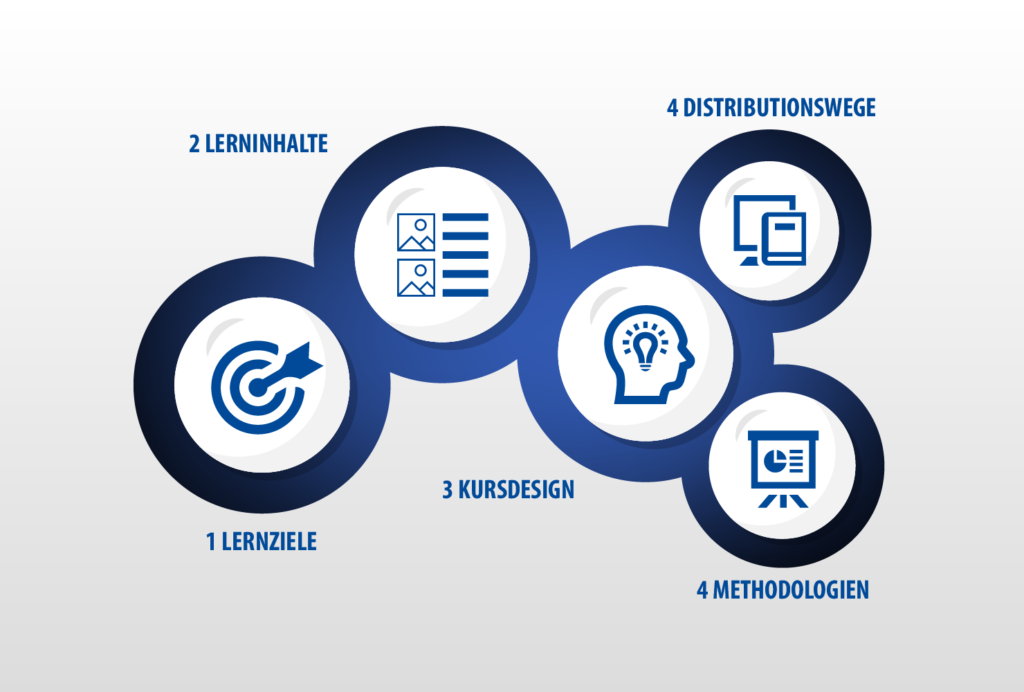Back to the ‘old normal’ of face-to-face training, continue with webinars or develop modern, flexible learning scenarios?
Many companies are asking themselves this question after their initial experiences with the digitalization of training measures in times of social distancing. One promising answer lies in the development of a sustainable training strategy that focuses on blended learning approaches. These combine the flexibility and scalability of digital formats with interactive and varied learning experiences. For such concepts to be successful, planning and implementation must be well thought out.

Clear learning objectives as the basis for success
The first step in planning a blended learning program is to analyse the target group and the framework conditions. The aim is to understand the needs of the participants, the context in which they learn and the challenges posed by their work situation. This is followed by the definition of the learning objectives: What skills and competencies should the participants have after the training? What specific changes in behavior should be achieved?
These clear learning objectives form the basis for the selection of learning content. On the one hand, essential content must be defined that contributes directly to the achievement of objectives, such as necessary specialist or factual knowledge. On the other hand, supporting content – such as management models, communication approaches or specific use cases – can help to anchor the learning objectives and facilitate transfer into practice.
The methodology: combining flexibility and interactivity

Once the learning objectives and content have been defined, the question arises as to which methods and technologies are best suited to convey them. This is where a mix of methods comes into play, combining the strengths of different formats.
Self-learning modules are ideal for teaching basic knowledge. Participants can learn at their own pace and receive continuous feedback on their learning progress through interactive exercises and quizzes. These modules are also location- and time-independent and therefore particularly flexible.
Building on this, webinars offer the opportunity to deepen content, clarify questions and engage in discussions with other participants and instructors. This direct exchange promotes understanding and enables theoretical knowledge to be put into a practical context.
In a next step, what has been learned can be put into practice in the form of projects, either individually or in groups. Such projects enable participants to directly try out and consolidate their knowledge. At the same time, working in a team promotes communication and exchange.
To support collaboration, asynchronous and synchronous communication tools should be integrated. Forums, chats and moderated discussion rooms create space for exchange and help to build a learning community that sustainably strengthens the learning process.
Scalability: customise training formats to suit your needs
In addition to content and methodological planning, the scalability of the training formats plays a decisive role. While webinars impress with their live interaction and manageable group sizes, they quickly reach their limits when the number of participants increases.
E-learning modules, on the other hand, are almost infinitely scalable if they are well thought out and offer meaningful opportunities for practice and feedback. These modules can be supplemented by forums, chats or partner work to promote exchange between learners. A sensible combination of scalable formats and interactive live elements can help companies to reach a larger target group without sacrificing quality.
Efficient creation through agile workflows and suitable tools

In a fast-moving world of work, flexibility and efficiency in the development of learning formats are essential. Agile workflows and the right tools can make all the difference here.
Tools such as the online-based authoring tool EVOLUTION³ facilitate real-time collaboration. Departments and external partners can work together on content, which significantly speeds up the creation process. Review and approval processes can be made more efficient, and central functions such as content management enable the administration of design, content and language variants.
Thanks to integrated templates, course materials can be quickly created that are both visually appealing and didactically well thought out. Such tools not only promote the quality of the content, but also reduce the time and organizational effort required for development.
Conclusion: A future-proof training strategy with blended learning
Blended learning measures are far more than just a replacement for traditional face-to-face events. They offer the opportunity to make continuing education more flexible, scalable and interactive. A clear strategy that takes into account learning objectives, methodology and the selection of suitable tools is crucial for success.
With a well thought-out mix of didactic design and innovative learning formats, companies can not only respond to current challenges, but also develop a future-proof and resilient training strategy.

